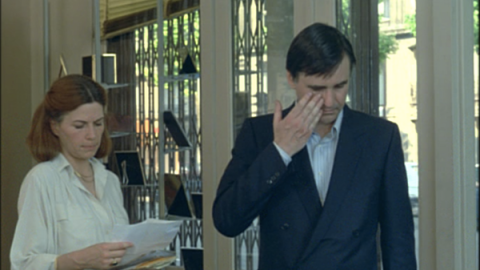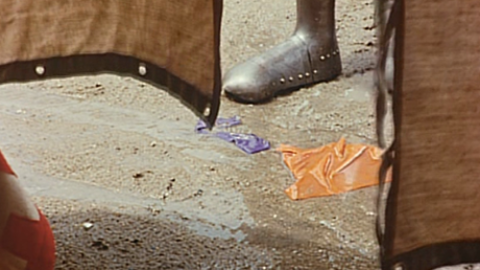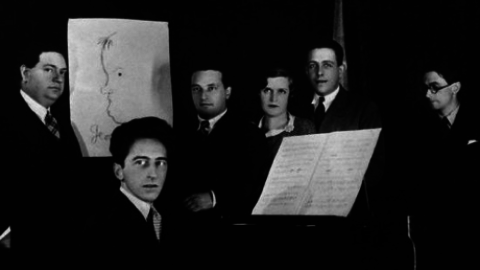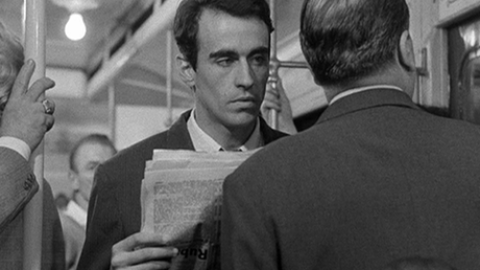↔ (Part One)
Discussions of Bresson over the past 10 years or so often begin with a kind of ritual un-saying of all the dead words that have accumulated around him (ascetic, austere, severe, demanding, slow, transcendent, Jansenist, minimalist). For all that effort, those words seem to retain their power to cling, remain a fixture in the Critical Dictionary of Received Ideas. I don’t find any of them too interesting, and a couple seem demonstrably wrong. “Slow” is an especially strange one since it’s tough to think of many other movies comparably fleet and taut—maybe some Warner pre-codes, maybe Armored Car Robbery or T-Men. There are frequent and surprising points of contact between Bresson and the “hardboiled,” the poetry of unadorned nouns and verbs found in Hammett and Paul Cain, so it’s appropriate that his closest stylistic analogue among American directors is probably Jack Webb.



Dragnet
But I don’t want to oversell this image of a two-fisted Bresson either, because I increasingly feel that the problem lies less with the choice of -ism or adjective than the desire to come up with any encapsulating formulation “Bresson is [X].” It’s common to both Schrader/Sontag and some of their critics, with the value of [X] either overturning into its opposite (transcendentalist into materialist, for example) or making a similar large-scale shift on a dubious evolutionary timeline (believer to atheist, say). This desire to circumscribe the films within some totalizing impulse goes against what seem to me their basic energies, though I’m sure at some point I’ll have recourse to the formula too. So I’d like to ask in advance that each such usage be read as accompanied by an invisible asterisk and the qualification “is also elsewhere.”
I can’t think of another artist whose work I’ve engaged as often or for as long where the basic question “what interests him/her?” remains so alive and elusive—every time I return to the films, my answers are different, sometimes slightly, sometimes radically. I think this may in part be because Bresson’s work, and the later films in particular, seems to perform some alchemy of opposed elements: his narrative structures, considered in outline, often have the feel of theorems (though in proof of ??), while their realization seems wholly invested in process.
It’s this process-oriented aspect of Bresson that’s inevitably elided whenever anyone tries to assign him a fixed position, but the temptation to make such an assignation is understandable given the peculiar affect of the films, their distinctive fusion of clarity (of the observed moment) and opacity (of the chosen vantage, the overhanging sensibility). Maybe another way to put it is his attentions are patient in their individual operations but seem to spring from a deep impatience: a restlessness, with regard to the habits of thought and perception, especially his own. I love this line from his interview with Michel Ciment: “The thing that struck me when I used to go to the cinema was that everything had been wanted in advance.” I see in Bresson a continual desire to overturn his own mastery (that which he knows he can do) and launch out instead on the fool’s quest, in search of the thing he never knew he wanted. One can see similar urges at work in Godard, Rivette, or others, but its presence in Bresson’s films is weirder since the shapes the films take on in the mind seem comparatively self-contained, angular, and crystalline (for the late ones in particular, in the interval of black leader that follows the last shot, I hear that “click of a well-made box” that told Yeats when a poem was complete).



A Damsel in Distress
(Free Association: With that, I think of L’Argent, Norbert’s mother in the photo shop, the prim click of her purse, the rhyme of the sound with the brittle gloss of her nails. There’s a particular cine-synesthesia that’s unique to Bresson. Then the first racetrack robbery of Pickpocket, a muffled, illicit click, Michel’s brief eye flutter. His quarter swing around the tram pole, the ding that sounds just as he lands on the street. All these tiny dances. Which in turn remind me of another artist who seems to me to stand in more provocative proximity to Bresson than Ozu or Dreyer—Fred Astaire—and most directly of his beautifully free and unspectacular street solo in A Damsel in Distress, “I’m Dancing and I Can’t Be Bothered Now.” Which reminds me of Arlene Croce’s description of another Astaire solo—“those ratcheting tap clusters that fall like loose change from his pockets.” Almost every moment in a Bresson film drops a nickel once you learn where to look.)



Pickpocket
I’m tempted to aphorize: one recognizes a great work by virtue of its impossibilities. But this might be my own rhetorical, or maybe metaphysical, hang-up. I do feel, though, that for Bresson in particular the challenge is less to pinpoint a position (that may be a challenge, but I think it’s one that does violence to the work) than to identify a possible field of activity, through triangulation. It will be interesting to see whether this holds up as we talk about Lancelot.
One last thing: At the risk of pratfalling into the intentional fallacy, I have to say that I’m always interested in what Bresson himself says of his work. Not because he expresses any coherent dogma or doctrine but rather because of the manner in which he occupies each of the positions he speaks from, as at least a way station. Many of them point somewhere pretty far away from that flock of adjectives I listed up top. I think I might close each of my entries with a quote. Here’s one from his 1967 interview with Godard and Michel Delahaye:
“And, as we go on making films, it is good, and it is agreeable, to feel that the audience, suddenly, is trying to put itself in our place and to love what we love. To sum up, it is a matter of making oneself loved. Loved in what we love, and in the way in which we love things and people.”
“I’ve only been involved with a few video-essays, but in each of them I’ve really tried to find some means of approach that felt congruent with the subject—to be, not reverent, but respectful. The idea of screwing around with Bresson’s images, or gabbing over them, felt alien to their texture, so there’s no narration, distortion, or superimposition here. It’s possible that the result will only be entertaining to me and a handful of bagpipe enthusiasts, but I do think that it offers a potentially useful arena for engaging some of Bresson’s core strangenesses, among them: fundamental issues of sound/image relation, his oblique strategies for organizing and linking spaces, the surprising diversity of his approaches to the thing seen, his complicated rhythms and freely patterned sets of repeating elements, and the lines of tension (not necessarily connection) between Bresson and “structuralism.” I also hope that the video pays some tribute to Bresson as a great director of action. There’s a memory game you can play with it, if you keep in mind that the video starts from the center of the sequence and ripples outward.”







